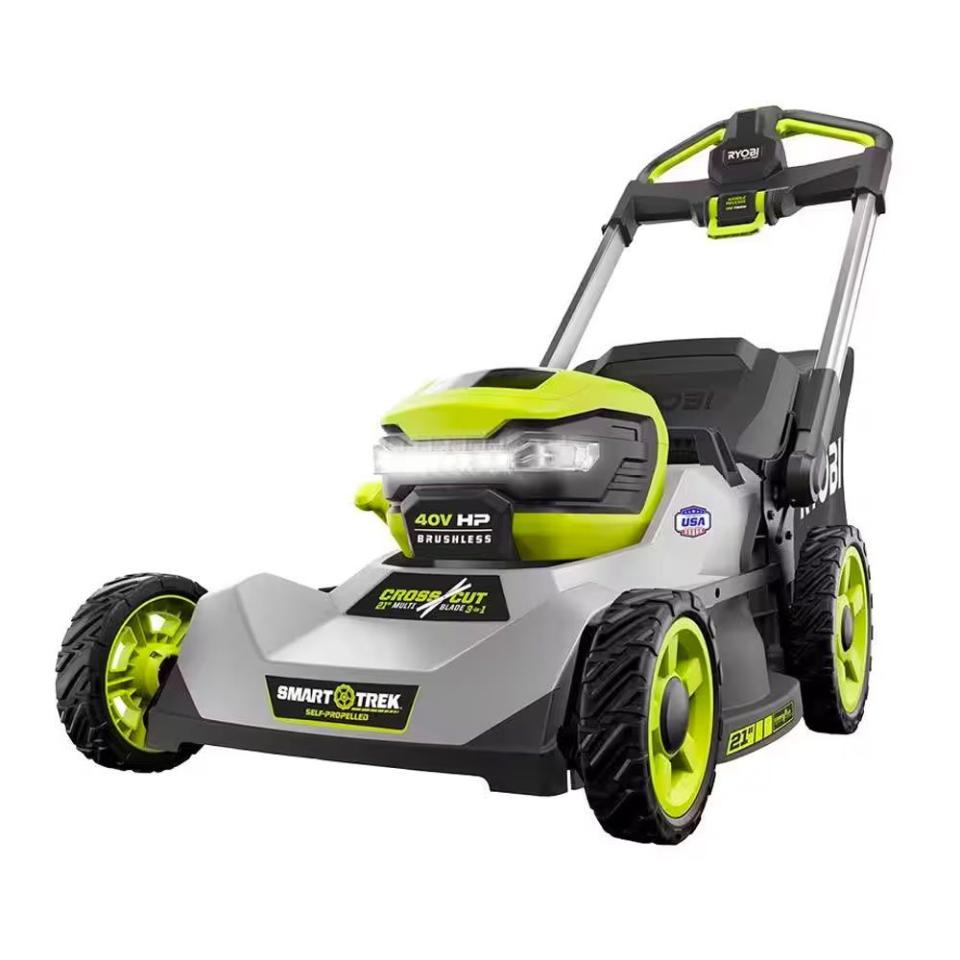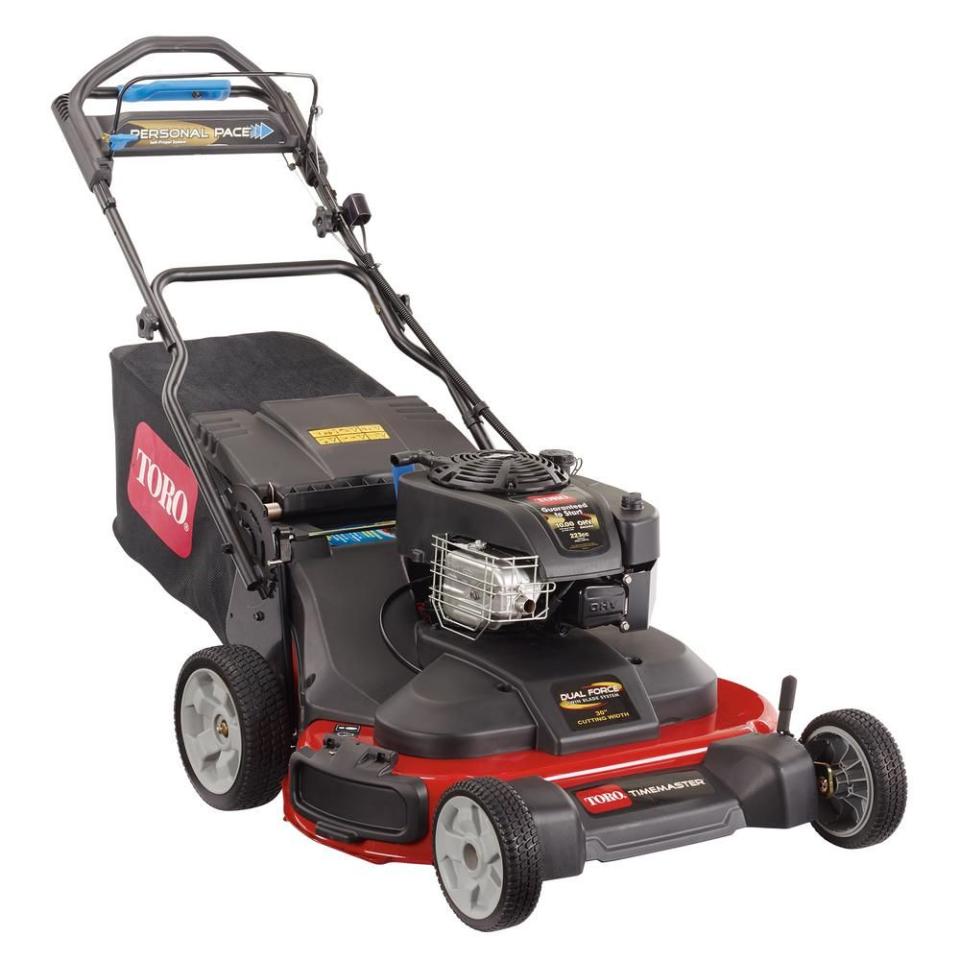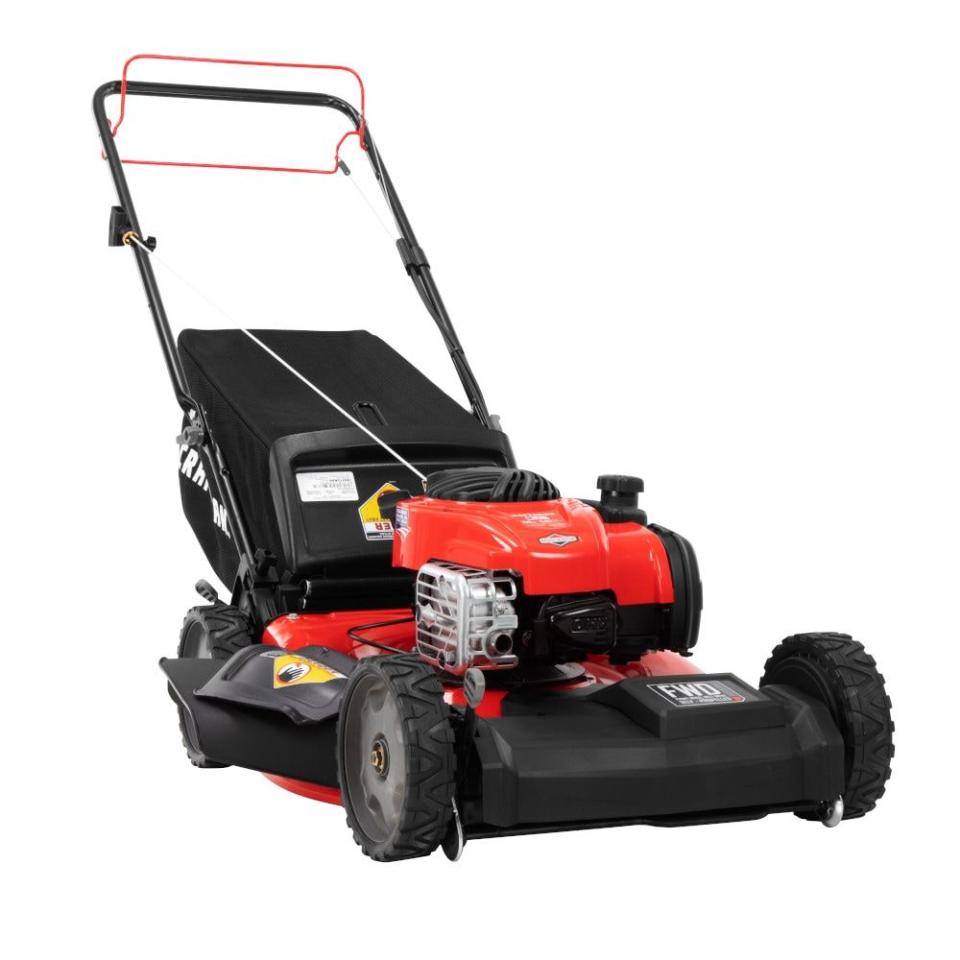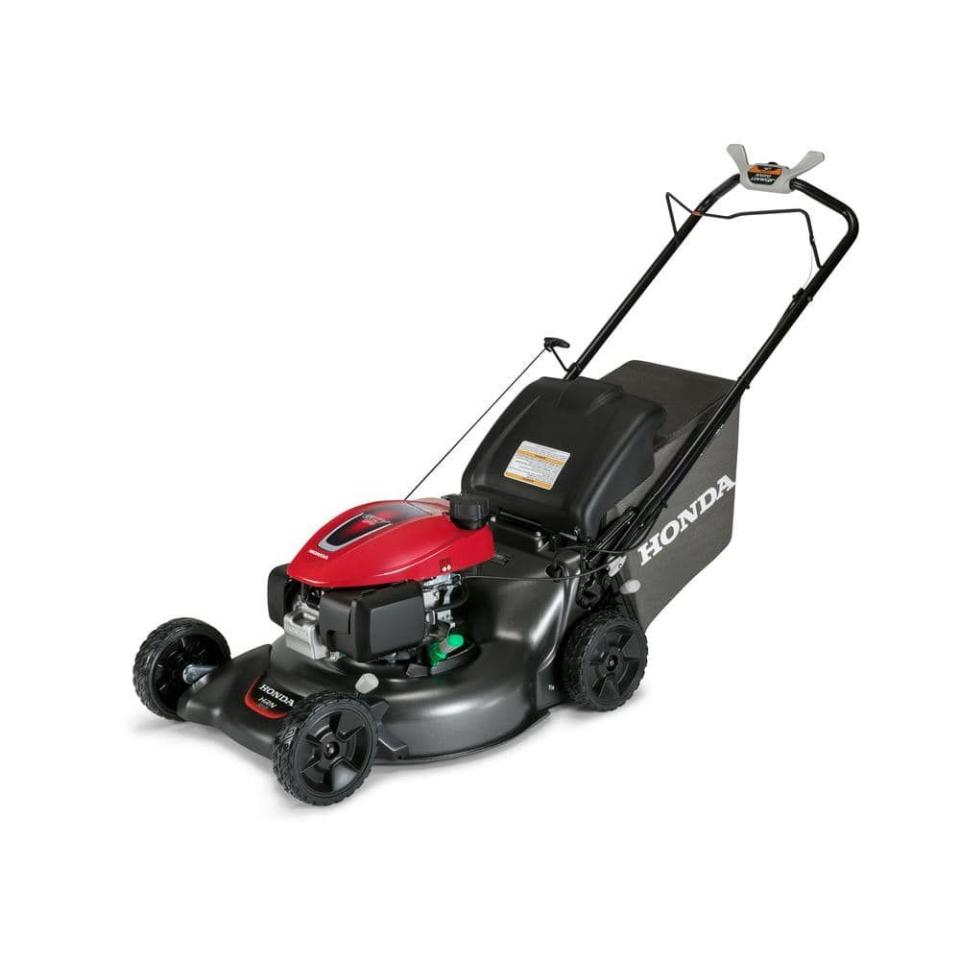The Best Self-Propelled Lawn Mowers for Making Your Yard Work Easier

"Hearst Magazines and Yahoo may earn commission or revenue on some items through these links."
One of the perks of the warm-weather season is getting to spend time outside. If you own your own home and have a yard, it's very likely that in order to enjoy your outdoor space, you need to mow the lawn. The larger the yard, the more work it will be to maintain. If you have a lot of grass to cut, you'd be wise to consider a self-propelled lawn mower.
The primary difference between a standard push mower and a self-propelled mower is that the former moves when you push it, and the latter essentially moves itself with only your guidance. Once the engine is running, all you have to do is squeeze a handle or push a lever and the mower will start moving forward with you as you walk.
Turning the mower around is your job, but once you have your heading, just keep the drive handle squeezed and escort the mower down the path, no pushing necessary.
Self-propelled law mowers take power off the engine and route it via a belt to a pulley on the transmission and axle. When you move the drive control lever on the mower handle, you tension the belt, causing the pulley to turn, and this drives the transmission, moving the mower forward.
Move the drive control lever back and the tension is released, the pulley stops turning, and the mower stops moving forward. The belt-driven transmission is a time-tested design to power the mower and take the load off you in the process.
The Best Self-Propelled Lawn Mowers
What to Consider
A mower is like many consumer products in that the more features a manufacturer adds, the more expensive it becomes. But a longer or more eye-catching list of features isn’t necessarily better. Sometimes less is more. Here are the most important to keep in mind.
▶ FRONT- OR REAR-WHEEL DRIVE Front-wheel drive mowers tend to be less expensive than rear-wheel drive units. They can be easier to turn because you don't have to disengage the drive wheels to do so. Simply push down on the handlebar to raise the front wheels off the ground. However, their traction isn't as strong on hills or when the bag is full, as there isn't as much weight over the drive wheels.
Rear-wheel drive mowers do cost more and aren't as easy to turn, as you do need to disengage the drive—but this isn't too much of a hassle. Rear-wheel drive mowers shine on hills and inclines, and when the grass bag is full. In either scenario, weight is shifted rearward and over the drive wheels, which enables superior traction, thus making the self-propel more effective.
▶ ENGINE SIZE An engine as small as 125 cc can power a mower, but most are somewhere in the 140 cc to 190 cc range. A large engine helps when powering through tall, lush grass or in extreme conditions, such as with a side discharge chute in place and mowing tall weeds in a border area. Also, the extra torque provided by a larger engine can improve bagging when the going gets tough (tall, leaf-covered grass in the fall). But if you mow sensibly and pay attention to deck height—and especially if you don’t let your lawn get out of control—an engine between 140 and 160 cc has more than enough power to get the job done.
▶ REAR WHEEL DIAMETER A mower can have all four wheels the same diameter (7 to 8 inches), or it may have rear wheels that range from 9.5 inches to 12 inches in diameter. Larger rear wheels help the mower roll more easily over bumpy ground.
▶ ELECTRIC START With some mowers you can start the engine with the twist of a key or the press of a button. It’s a great option, but a luxury. Keep the mower engine tuned and use fresh fuel with stabilizer added to it, and you’ll never have trouble starting.
▶ SPEED CONTROL Any number of mechanisms can control a mower’s ground speed—a squeeze handle, a drive bar that you press forward, even a dial. There’s no single right answer here. Look at the design and think about how you like to work. For example, if more than one person will be using the mower (and not all of them are right-handed), a drive control like that on a Toro Personal Pace mower might be the answer. Just push down on the bar to make it go faster. Let up on the bar to slow down.
▶ TWO OR THREE-FUNCTION A mower that can bag, mulch, and side discharge is known as a three-function mower, the most versatile kind. Two-function mowers bag and mulch or mulch and side discharge.
▶ DECK HEIGHT CONTROL Mowers will typically have one, two, or four levers to control the deck height. Single-lever adjustment is the easiest to use, but it requires more linkage, which adds weight and complexity. If, for some reason, you find yourself varying deck height frequently, it’s a good option. Otherwise, two or four levers work just fine.
▶ DECK MATERIAL Only Honda makes a gas-engine mower with a high-impact plastic deck (there are battery mowers that have plastic decks). Otherwise, mowers generally have a steel deck, and a few manufacturers—Toro, for one—offer a corrosion-resistant aluminum deck. An aluminum deck won’t rot the way a steel deck will, but you still need to keep it clean.
▶ DECK WASH This is a hose fitting mounted on top of the mower’s deck. When you’re done mowing, hook up a hose and run the mower to power wash the underside of the deck. We’ve had mixed results with these, but they’re better than just letting a mass of dried grass clippings accumulate.
▶ BAG QUALITY More expensive mowers come with a more durable bag with more dust-blocking capability. If you bag a lot, especially leaves or other lawn debris in the fall, then you need a mower with a higher quality dust-blocking bag. Having said that, if you rarely bag, the standard one that comes with a mower will last you the life of the mower.
▶ WIDE-CUT Also called wide-area mowers, machines in this subgroup help homeowners better reconcile their need for more power and speed with the fact that they may not have enough storage for a tractor or zero-turn mower. A typical residential walk mower has a single-blade deck that cuts a swath from 20 to 22 inches wide. Wide-cut mowers (built for homeowner use) have either a single blade or, more typically, a pair of blades, cutting from 26 to 30 inches with each pass. Some of these are rated for light commercial use and have larger decks, in the 32-inch range, and engines that start at 223 cc and go up to about 337 cc.
Wide-cut mowers typically employ gear or hydrostatic drive transmissions, and they have top speeds of about 4 to 6 miles per hour. At their fastest, they move so quickly you have to trot to keep up with them. Needless to say, they’re overkill for small yards; only opt for one of these if you’ve got a significant plot of land that you need to keep tidy, but not one so large that you’d be better off going with a full-on riding mower.
How We Tested and Selected
We compiled this list based on Popular Mechanics mower testing and our knowledge of the lawn mower market at large. For our testing, we put mowers through the paces using our standard Popular Mechanics methodology: We cut turf grasses such as fescues and blue grass and rougher non-turf grasses like Timothy, clover, orchard grass, and wild oats, all in both normal and shin-deep heights. We mow uphill, downhill, and across the faces of hills. The maximum slope we cut is about 30 degrees.
That may not sound like much, but it’s about all you can do to stand on it, let alone push a mower up it or across it. We mow damp and wet grass to test general cutting performance and whether clippings accumulate on the tires. And we cut dry and dusty surfaces to see how well the bag filters under less-than-optimal conditions.

Recycler 60-Volt Max Lithium-Ion
$729.00
homedepot.com
Toro mowers have garnered more recommendations from us than any other brand for two reasons: build quality and cut quality. These were amply demonstrated in our testing as the Recycler turned in the best ratio of cut area per amp-hour of battery in the self-propelled category, while at the same time not skimping on cutting, mulching, or bagging quality.
We attribute this outstanding mower performance to three features, all upgrades to the previous version of this machine. First, the air vent at the front of the mower deck seems to improve mulching and bagging performance. Toro calls it Vortex technology, a design that increases air flow under the deck. This helps to stand the grass for a cleaner cut, which improves mulching performance, and also allows better airflow into the bag when collecting the clippings.
Next, the company’s redesigned “Atomic” blade configuration appears to assist the air flow and clipping movement. Finally, the three-phase, 60-volt motor is exceptionally efficient, resulting in a large cut area for a single battery.
Toro has maintained features that make this mower work: rear wheel drive, a one-piece deck that’s all steel (no plastic nose), 11-inch wheels to help it roll over roots and crevices, and the same fold-forward handle that was an industry breakthrough when it was introduced some years ago.

40-Volt Brushless Self-Propelled Mower
$799.00
homedepot.com
This is one of Ryobi’s top-of-the-line mowers, and it’s American-made construction is something we wish we saw more of. It delivers a tremendous cut area with its two 6-Ah batteries providing a total of 12-Ah of capacity, and its X-shaped blade leaves a pristine surface in its wake.
Ryobi estimates the design should provide 70 minutes of run time; we didn’t time our cut, but it strikes as plausible. Its rear-wheel drive and reasonably aggressive tire tread pattern provide good hill climbing and sidehill cutting performance, and its bagging on all surfaces (level, sidehill, and uphill) is also commendable.
Other ease-of-use features include an easily installed or removed bag that mounts and dismounts straight up and down through the handle; deck adjustment is quick and easy thanks to a single-level deck height adjustment. The straight edge deck is polypropylene; it will never rust and needs very little care other than basic cleaning.

TimeMaster
$1599.00
homedepot.com
The Toro Timemaster 30-in. mower has been around for several years and has earned a reputation as a sturdy workhorse for homeowners who want to cut down on their mowing time. It's also used by some professionals as well. A few years ago the Timemaster got a slightly more powerful Briggs and Stratton gas engine, so it should have no issues powering through most demanding mowing jobs.
The Timemaster is rear-wheel drive and features Toro's Personal Pace drive system that's used on many of its self-propelled mowers. This allows the mower to move at your speed by simply pushing down or releasing the handle, which is spring-tensioned.
With a 30-in. deck, Toro claims the Timemaster will help you reduce your mowing time by about 40% compared to using a standard-sized mower. You can mulch, back, or side discharge with the Timemaster, and the handlebar can be locked in a fully vertical position to reduce space consumption in storage.
If you have half an acre to a full acre of lawn to mow and prefer the experience of a walk-behind mower versus a tractor or zero-turn, the Timemaster is worth a look.

M215
$419.00
lowes.com
Craftsman mowers have been doing very well in our tests, so we can recommend this one because it’s so much like the many other of the brand’s models that we’ve tested. If you’re looking for a good blend of maneuverability and power, you’ll get it with this mower. Its front drive helps move it along and makes it easy to turn.
It’s important to note that front-drive mowers do lose some traction when running uphill, particularly with a full grass bag. But if your slope is less than 20 degrees, and you’re not bagging uphill, you’ll be fine. The side discharge will also help you handle tall grass. Adjust the two deck levers to bring the mower up to full height and have at the rough stuff.
The fact that this mower bags, mulches, and side discharges is a plus, enabling you to handle a wide range of mowing conditions, from early spring and late into the fall. Three-function mowers like this are our preference for that versatility.

Super Recycler Self-Propelled Lawn Mower
$799.00
Tractor Supply Company
This is a beauty of a mower, with a cast-aluminum deck and a smooth-running Briggs & Stratton 163-cc engine. We tested the Honda engine-equipped version, and it was effective at both bagging and mulching, even in moist grass.
Equipped with rear-wheel drive and the Personal Pace system (the farther you push the drive bar, the faster the mower goes), it’s an effective hill climber and moderately effective on sidehill cutting. It has relatively small 7.5-inch tires on all four corners, which causes this Toro to bump up and down a bit on washboard surfaces. But the good news is that it’s equipped with a far higher quality tire than we’re used to seeing these days. We didn’t notice them pick up any grass on moist surfaces.
Other features we like include its forward-fold handle that has a built-in shock absorber that Toro calls a Flex Handle Suspension, and a high-quality grass bag that loads through the handle, from the top.

HRN 216VKA
$549.00
homedepot.com
Honda mowers enjoy a sterling reputation. Having tested their walk and self-propelled mowers for the last 30 years, we feel confident that Honda's entry level mower is a great choice for homeowners looking for power and durability, even with its premium price tag. The HRN features a GCV 170 gas engine that's built to withstand long hours of operation.
If you do your own maintenance (and most owners who buy this class of product do), you’ll appreciate the easily accessible spark plug and the fuel shutoff valve that enables better winter storage. Close the fuel shutoff and run the mower until it sputters to a halt. This will clear the carburetor of any gasoline, which will prevent the ethanol in it from disintegrating and causing running issues later on. Open the shutoff valve in the spring, add some fresh gasoline, and the mower should start easily.
All this maintenance stuff is great, but we can also tell you that our past test findings on other Hondas prove that their cut quality is outstanding for cleanliness. Sharp blades deliver a velvet-like finish. And their bagging ability is also quite good, in the same league with other well-bagging mowers from Toro.
In all, if you take mowing seriously, you should enjoy this Honda. If you have a little wiggle room in your budget, consider the Honda HRX, which features a mower powerful engine and a composite deck that won't even rust and is renowned for its durability. One note is that Honda has announced that it will cease selling lawn mowers in the United States after this year—so if you're considering buying one, best do it sooner rather than later.
Q+A
PM: Are there special maintenance considerations with self-propelled mowers?
RB: Yes. Both front- and rear-wheel drive mowers feature a drive belt, which can crack or wear out over time. Fortunately these belts are not difficult or particularly expensive to replace.
Secondly, you may have to replace the drive wheels occasionally. These wheels are driven with gears - there are typically teeth on the inside diameter of the drive wheel that line up with a gear on the axle. These teeth can wear out, especially if they are made of plastic. Higher-end mowers may feature drive wheels with a metal gear that meets the metal axle gear, which improves longevity of these components.
PM: My lawnmower says I don’t ever have to change the oil, but just add oil when needed. Is this OK?
RB: It’s not a good idea to never change the oil in your lawn mower. In a lawn mower, same as a car, oil degrades over time and is less effective at reducing heat and friction in metal components. Changing the oil in your lawn mower is easy to do and will significantly increase its service life. For most homeowners, changing the oil at the beginning or end of each mowing season should be sufficient, though there is certainly no harm in doing it more often.
You Might Also Like

